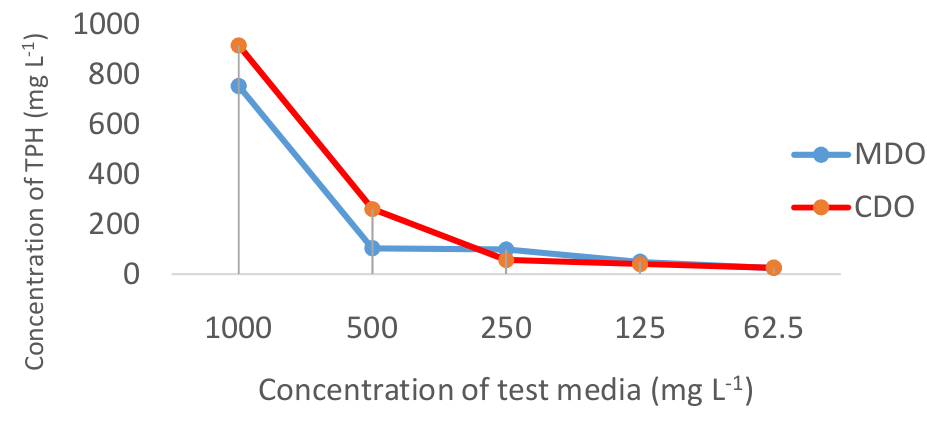Physicochemical Characteristics and Toxicity Studies of Crude Oil, Dispersant and Crude Oil-Dispersant Test Media to Marine Organisms
Keywords:
Ecobest® dispersant, Tilapia guineensis, Palaeomontes africanus, Crude oil, Toxicity studyAbstract
In this study, the physicochemical characteristics of crude oil, dispersant and crude oil-dispersant test systems and their toxicities on representative marine organisms in a simulated marine ecosystem was assessed. Mechanically dispersed crude oil-in-water test system (MDO) and its water accommodated fraction (WAF) alone, and in combination with a third generation dispersant (D) (Ecobest®), which gave rise to chemically dispersed crude oil-in-water test system (CDO) and its water accommodated fraction (CEWAF), as well as a reference toxicant, sodium dodecyl sulphate (SDS) were used to evaluate toxicities on selected marine organisms (Fish – Tilapia guineensis, Crustacean – Palaeomontes africanus, and Bacteria – Total heterotrophic bacteria and hydrocarbon utilizing bacteria). Physicochemical characteristics were done using standard methods. The static with renewal bioassay option was employed for toxicity tests involving Fish and Crustacean, while the static without renewal option was used for microbial bioassays. Marine organisms were exposed to the following concentrations: 1000, 500, 250, 125, 62.5 and 0 mg/L of MDO, CDO, D, WF and CEWAF, respectively. The LC50 (lethal concentration that resulted in 50% mortality) at 96h and toxicity factors were determined. Results for physicochemical characteristics of the test systems showed that the pH, dissolved oxygen levels were sufficient for sustaining aquatic habitation. Lead metal was present in high amounts in the dispersant test system, but relatively low in chemically dispersed test systems. Cd and Ni were also present at relative amounts that could be toxic to aquatic lives. Toxicity data showed that the new dispersant, Ecobest® was non-toxic to the tested marine organisms relative to the reference toxicant (SDS), which was moderately toxic. The 96h LC50 of MDO, CDO, D, WAF, CEWAF and SDS were 89.8, 225.6, 1891.8, 683.9, 528.1 and 1.37 for T. guineensis, and 275.5, 137.7, 3800.9, 76.1, 168.3 and 9.99 for P. africanus, and 1658.5, 944.1, 17221.9, 228641.0, 1036319.3 and 3.84 for total heterotrophic bacteria. The reference toxicant, SDS, was the most toxic of the toxicants, but the dispersant reduced the toxicity y several folds. However, with the presence of some heavy metals, notably Pb, Cd and Ni, and some levels of polycyclic aromatic hydrocarbons in the test media water, there may be likelihood for bioaccumulation to occur in the tissues of marine organisms.

Published
How to Cite
Issue
Section
Copyright (c) 2022 Journal of the Nigerian Society of Physical Sciences

This work is licensed under a Creative Commons Attribution 4.0 International License.







